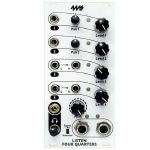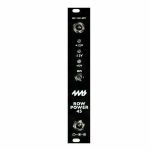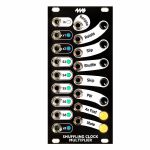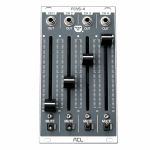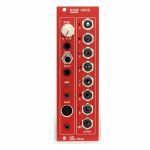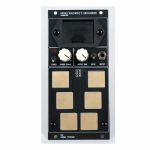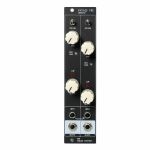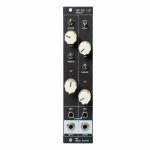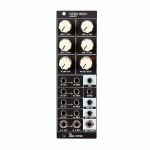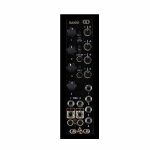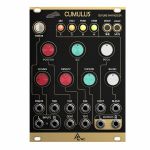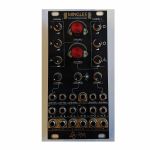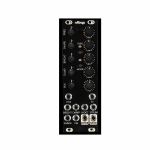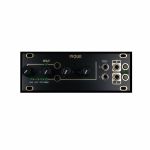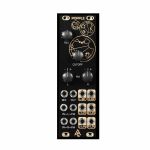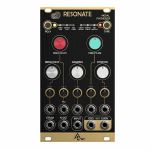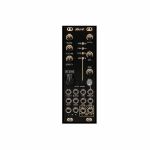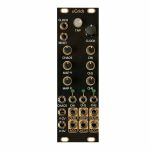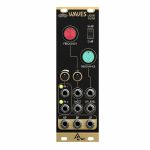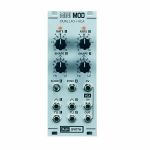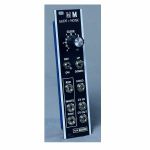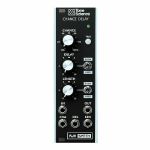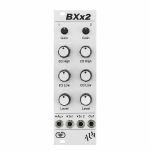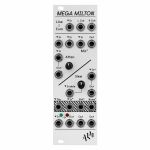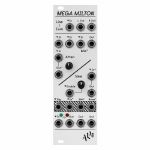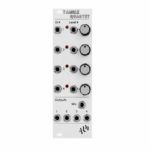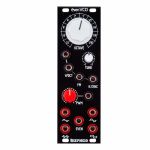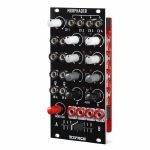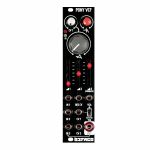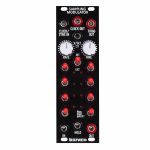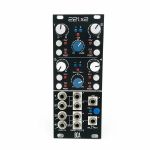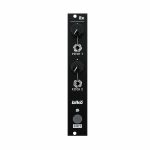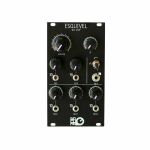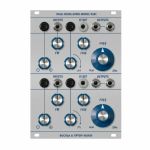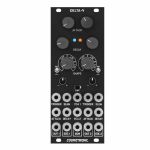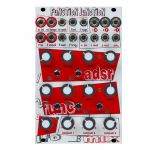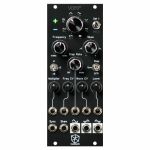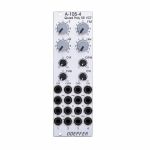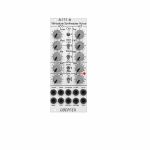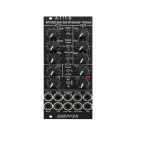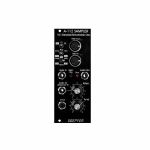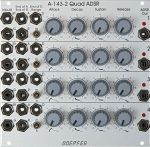Studio equipment
Our full range of studio equipment from all the leading equipment and software brands. Guaranteed fast delivery and low prices.
DJ equipment
Our full range of DJ equipment from all the leading equipment and software brands. Guaranteed fast delivery and low prices. Visit Juno DJ
Filter
Stock
Release Date
Brand
Featured
Price
Tags
Synth modules

quote 717581
Crystal-clear clock-synced delay for loop up to 90 seconds, echoes, sound-on-sound, Karplus-Strong etc.
Features:
Loop or echo time is synchronized to a clock
87 seconds of delay/loop time maximum
48kHz/24-bit sampling rate, loop recorded at 16-bit (24-bit optional)
Extremely quiet, low noise and low jitter design
Tap tempo button and clock Ping input set the basis for one "beat"
Delay/loop time set as a number of musical beats (or fractions of beats) using the Time knob, switch, and CV jack
Sample-accurate clock output for perfect synchronization
Loop clock outputs for each channel
Time switches change range of Time knob from 1/8th notes up to 32 bars
Digital feedback, up to 110%
Delay Feed control, independent of dry/wet signal mix
Infinite Hold mode disables recording input and fixes regeneration at exactly 100%
Reverse mode plays memory contents backwards
With an infinite loop locked, knobs or CV can "window" around memory, by shifting the loop
Trigger inputs for toggling Infinite Hold and Reverse
Send and Return for applying effects to feedback with external modules
CV jacks to control Time, Level, Feedback and Dry/Wet Mix
16HP Eurorack module
Specs:
48kHz, 24-bit low-noise hi-fidelity
Up to 90 seconds of loop time
16HP
+12V: 110mA
-12V: 45mA
Included with the Looping Delay:
16-to-16 pin power cable
4 x M3 Knurlie screws
1 in stock $181.13
+12V @ 1.4A
-12V @ 1.25A
+5V @ 1.0A
Simply plug a universal power supply (laptop style) into either of the barrel plugs on the 4HP panel. Connect your modules via flying-bus cables or the Bus Stick.
Daisy-chain multiple Row Powers to use a single power brick for multiple rows (typically 3-5 rows per power brick). Each row will be independently regulated and protected for ultra-low cross-talk between rows. Rows can also be hot-swapped (plugged/unplugged without powering the whole system down).
quote 739048
+12V @ 2.0A maximum, 1.5A recommended
-12V @ 1.4A maximum, 1.2A recommended
+5V @ 1.5A maximum, 1.2A recommended
Simply plug a universal power supply (laptop style) into either of the barrel plugs on the 4HP panel. Connect your modules via flying bus cables or the Bus Stick. For custom power systems, the Row Power 45 has a set of easily soldered holes for using large gauge wire or MTA156 connectors to connect to distribution bus boards.
Multiple Row Power modules can be powered from a single power brick by daisy-chaining with an inexpensive barrel cable. The Row Power 45 can also be daisy-chained to 4ms Company's Pod enclosures. Each power supply is independently regulated and protected for ultra-low cross-talk between rows/pods.
The Row Power 45 is compatible with the 4ms Row Power Shield. This device (sold separately) attaches to the back of the Row Power 45 and monitors the amount of current being drawn, as well as the voltages of the power rails. The information is sent over Bluetooth to be displayed on a phone or tablet.
Electrical and Mechanical Specifications
Module Size:
4 HP Eurorack format module
Power Output:
Maximum average load under normal conditions: +12V @ 2.0A, -12V @ 1.4A, +5V @ 1.5A
Maximum average load under any condition: +12V @ 1.5A, -12V @ 1.2A, +5V @ 1.2A
Powered by laptop-style DC power supply: 2.1mm barrel, positive center, 15V-20V.
Included with the Row Power 45:
16-to-16 pin power cable
2 M3 Knurlie screws
quote 785962
Specs:
Electrical and Mechanical Specifications
12HP Eurorack format module
0.95" (24mm) maximum depth (includes power cable)
16-pin Eurorack power header
Power consumption
+12V: 52mA max
-12V: 15mA
Clock Input
2.5V threshold
40kHz maximum
Clock Outputs
12V gate outputs, rise/fall time approximately 1us
40kHz maximum
Jitter (x1 output): max 30us < 120BPM, max 5us >= 120BPM
Latency (clock in to x1 output): 8us worst-case, 3.5us typical
CV Inputs:
Rotate, Slip: Knob attenuates jack signal. Full range: 0V to +3.3V
Shuffle, Skip, PW: Knob offsets jack signal. Full range: -5V to +5V
Gate Inputs:
4x Fast, Mute: 2.5V threshold. Button toggles state.
1 in stock $172.17
quote 901317
The ACL Fader CV Source Module comprises 4 individual faders where each can generate a CV either going between 0 and +5V or 0 and +10V unipolar or -5V and +5V or -10V and +10V bipolar, selectable using 2 jumpers on the backside of the module.
Furthermore there are mute-switches for each channel accompanied with an dual color LED (green/red) which shows the channels mute status. When mute is activated or deactivated, short fade ramps will be generated as well as the fader itself is slightly slew-limited internally in order to generate a smooth CV.
This module is very useful to control VCA's or VC mixers like our VC Amp mix module.
quote 857430
The module provides CV outputs for all of the Nunchuck's parameters and special functions to remap the CV outputs. The remapping can be both continuous or step-by-step and can be accessed through either the dedicated CV inputs or the manual controls.
A specially dedicated Mix output averages between the first two CV outputs, a very useful feature for continuous control parameters.
Mechanical:
- Format: Eurorack
- Width: 8 HP
- Depth: 4 cm
Control Voltage I/O:
- CV inputs: 0 - 10v
- CV outputs: 0 - 5v
- Gate in threshold: 2.5v
Electrical:
- Compatible with +-12v and +-15v power supplies
. Max current: 100mA?
. Bus Board Cable: 8 × 2 IDC (Doepfer style) connector
1 in stock $165.12
This limited edition of 75 units is a tribute to the pioneering work of Dutch musician and instrument maker Michel Waiswisz (1949 - 2008), who first invented the Cracklebox with Geert Hamelberg in the late 1960s.
The Cracklebox was a small, handheld device designed as a way to explore new sonic territories. It was one of the first electronic musical instruments to use circuit bending techniques in the creation of electronic music. It allowed musicians to manipulate and control electronic circuits in real-time, creating a wide range of unique and experimental sounds. He used a circuit from a toy piano as the basis for the instrument, and then added a series of touch-sensitive pads that were connected to the circuit. When a player touched one of the pads, the circuit would be completed, producing a crackling sound.
The Cracklebox was probably the first commercially available portable self-powered alternative 'keyboard' analogue electronic instrument with inbuilt loudspeaker.
In the 1970s about 4000 Crackleboxes were built and sold by STEIM in Amsterdam.
Nowadays many people refer to the The Cracklebox as the archetype of 'glitch' or 'circuit bending'.
In the decades since its invention, the Cracklebox has continued to be an important and influential instrument in the world of electronic music. It is still in use today, and is considered a classic example of the potential of electronic music to create unique and innovative sounds.
This Eurorack recreation includes a 9v battery, swappable through the front panel, this allows to isolate the current flowing through the user's fingers from the Eurorack frame PSU, protecting the user from undesired electrical shocks. The internal speaker has been removed, a transformer has been used instead to isolate the output signal.
The output generated can be used as an audio, as a gate or a cv signal, when using it as a cv source, due to the specific qualities of the signal, users may want to send it through other modules as slews, sample and holds, quantizers to tame/control it's peculiar cv output.
Controls:
- The module features an on/off switch to turn off the 9v battery (remember to turn it off when you turn off your Eurorack system).
- A Power Starve knob, reduces the 9v voltage feeding the circuitry changing it's overall timbre/pitch
- An Output Gain knob to control the output volume.
- A Boost switch to add more presence to the signal.
Tech Specs:
12HP
5.5 cm deep
20mA +12V
20mA -12V
9v battery required
quote 958668
What was eye-catching was the character of its clipping and resulting saturation/distortion.
The module can be used with modular signals to add a distortion/fuzz character or as a preamp for an external source such as a line source, keyboard, guitar...
It's also a great side companion for our ADDAC711 Balanced Inputs.
At the top an On/Off [BYPASS] switch routes the signal into the Effect (Up: Active) or to the bottom output gain stage (Down: Bypassed).
The amount of amplification is set by the [GAIN] control, the maximum amount of amplification can be set by the user using the [MAX GAIN] trimmer.
Up to +/-5.5v the incoming signal will keep it's integrity, beyond this point saturation will start to increase.
At approx. +/-6v a hard clipping will start to occur, this clipping also has a particular quality that at extreme levels it drifts the audio 0v bias reference, moving it upwards which results are similar to a Gate effect.
In the middle, an x2 opamp based output gain stage with a clipping led, which monitors the clipping at the output, and an [OUTPUT] control to set the output volume.
Having the top and middle gain stages provides flexibility allowing the user to completely distort the signal on the top stage and tame it's output level with the second stage.
At the bottom, Input and Output for both channels (Left input is normalled into Right input).
Tech Specs:
6HP
4 cm deep
40mA +12V
40mA -12V
quote 917638
Inspired by the legendary Moog CP3 mixer, the 713 tweaks the old-school discrete circuits into three stereo inputs and one mono channel, summing to stereo with adjustable feedback and clipping to add character.
Supplier's Notes:
ADDAC713 is the stereo version of ADDAC System's 703 Discrete Mixer.
Inspired by Moog's CP3 mixer, this is a fully discrete analogue mixer and it's not, by any means, your standard breakfast mixer, although it can behave like one.
This is a wolf in sheep's clothing. Despite its harmless looks there's a dark snarly soul behind that panel that wants to take your sounds into a realm of gritty gnarly growls.
This new version was initially thought of as a percussion mixer, with mono inputs and panning, to allow placing percussive voices in the stereo field, while keeping channel 4 in mono for low end sources like a kick drum or Bass. In the development process ADDAC System slightly changed this initial idea, adding stereo inputs for the first 3 channels, but still kept the 4th channel in mono.
All four [GAIN] controls go to extreme levels, the first 3channels also feature [PAN] controls. Feedback is used to overdrive the whole mix. As the control is turned clockwise the sound will be clipped harder until it goes completely off, this happens as feedback is increased the audio bias reference also moves up, at extreme levels it offsets the whole signal upwards until it completely goes above the top rail clipping the whole signal hence the resulting gate effect.
The [MASTER OUTPUT] sets the overall output gain of the mixer, the two leds monitor the audio output signal. The Soft clipping switch engages an anti-click circuit which adds a low pass before the output, the switch allows 3 states: Soft low pass / Off / Hard low pass.
Features:
Three channels with stereo inputs, gain and pan knob
One channel with mono input and gainknob
Feedback/gate knob
Master output volume knob
Soft clipping switch
Two Led Monitors for Left and Right channels
Tech Specs:
8HP
4cm deep
80mA +12V
80mA -12V
Diode based passive clipping acts as a "brick wall" limiter with a fixed knee given by the inherent diode physics. A passive RC low pass circuit adds a 3.3KHz -3db low pass filter which sculpts the overall tone while also adding further character to the effect.
At the top an On/Off [BYPASS] switch routes the signal into the Effect (Up: Active) or to the bottom output gain stage (Down: Bypassed).
The amount of clipping is set by the [GAIN] control, it mostly works as a threshold control for how much clipping will be applied.
As more clipping is applied the signal's amplitude will also decrease, to compensate for this we set up a gain compensation stage to keep the output amplitude balanced across the Gain range.
Symmetry chooses between bipolar clipping or positive clipping, this relates to the harmonics generated, bipolar for odd and even harmonics (up position) and unipolar for odd harmonics only (down position).
At the second stage, an opamp based x2 output gain with a clipping led, which monitors the clipping at the output, and an [Output] control to set the output volume.
Having the top and middle gain stages provides flexibility allowing the user to completely distort the signal on the top stage and tame it's output level with the second stage.
At the bottom, Input jacks for both channels (Left input is normalled into Right input) and output jacks
Tech Specs:
6HP
4 cm deep
40mA +12V
40mA -12V40mA +12V
40mA -12V
quote 917651
Four channels with stereo input and gain knob. Fifth channel with stereo input without gain knob, which are the prefered inputs to cascade several ADDAC813s when more channels are needed. Master Output controls the level of the Inputs mix. Two LEDs monitor the inputs mix.
Mono Send / Return return path allows for easy integration of mono effects in a stereo chain. Plug your favorite module through it (filter, bbd delay, spring reverb...) or any mono pedal.
The Return Gain works in parallel with the Master Output, just like regular wet / dry controls.
The send output can be configured to be line or synth level via a jumper in the back.
Stereo output sums the Inputs Mix with the Return signal.
The Mono output is the sum of Left and Right outputs
Effect Pedals
Using the send output at Line level, the user can connect the send output directly into mono effect pedals and have the pedals output connected directly into the return input without the need of an attenuator/amplifier module.
Tech Specs:
8HP
4 cm deep
50mA +12V
50mA -12V
This product is available for pre-order at Juno, for shipping on the release date. You won’t be charged until the order is despatched.
We'll keep you informed of your order at every stage, and let you know if the release date changes.
If the price of the item drops before it's released, you will pay the lower price, but if it increases, you'll only pay the price you see today.
If you also include in-stock items on your order, they’ll be charged and shipped within 24 hours as usual.It can be an ADSR-style envelope generator, an LFO and a drum emulator. By default, the Dead Man's Catch (DMC) firmware will be loaded, which adds the Alt ENV, ALT LFO, ALT Tap, Alt Drum modes below.
The module is calibrated, comes with a power cable, and a one year warranty.
Additional Dead Man's Catch firmware modes:
Basic (original modes):
Envelope
LFO
Tap LFO
Bass/Snare Drums
Alternative ENV:
Double attack envelope
Repeating attack envelope
Looping envelope
Randomized AD envelope
Bouncing ball envelope
Alternative LFO:
Frequency-modulated LFO (folded sine FM)
Frequency-modulated LFO (random FM)
Varying wave shape LFO ( folded sine WS mod)
Varying wave shape LFO ( random WS mod)
Phase-locked loop oscillator
Alternative TAP Mini-sequencer:
ModSequencer
Pulse Shaper
Pulse Randomizer
Turing Machine
Bytebeats
Alternative DRUM:
FM drum Generators
Randomized bass and snare drum generators
Randomized high hat
quote 805024
quote 900381
Mixer section
Channel 1 and Channel 2 are three channel mixers with potentiometers to control level of three different inputs for each channel. Each channel then has a potentiometer to control panning as well as CV control for panning and level control
Panning and VCA
The VC panners are equal loudness panning and the VCAs for each channel are linear response.
Built-in LFO
There is a built-in LFO that is normalled to the panning CV input of each channel. CH1 gets the standard LFO and CH2 gets an inverse, enabling alternating channel panning. The default is to use a TRI wave for the LFO, but there is a jumper on the back to switch it to SQU.
Width: 12hp
12V: 140mA
-12V: 120mA
quote 1004349
This is a new build of a micro version of Rings from Mutable Instruments. MicroRings, also called NanoRings, retains all the same functionality as a full-size Rings module.
The module is fully assembled, tested, and calibrated. Eurorack power cable is included.
These modules use tall bushing potentiometers to offer a more stable feel.
quote 805521
This is a 1U (Intellijel format) version of the Pique module which is based on the popular Peaks module from Mutable Instruments. It can be an ADSR-style envelope generator, an LFO and a drum emulator.
The module is calibrated, comes with a power cable, and a one year warranty.
quote 805532
Pique is a micro version (4HP) of the popular Peaks module from Mutable Instruments. It can be an ADSR-style envelope generator, an LFO and a drum emulator.
The module is calibrated, comes with a power cable, and a one year warranty.
quote 805530
Popple will also self-oscillate at high resonance settings, when coupled with the v/oct CV control, it can also act as a dual sine wave oscillator.
quote 805174
Supplier notes:
This is an exact hardware replica of the Mutable Instruments Rings module.
quote 900386
This is a new build of the micro version of Mutable Instruments Clouds. The module retains all the functions of the original Clouds, taking up significantly less rack space.
These modules use tall bushing potentiometers to offer a more stable feel.
The module is fully assembled, tested, and calibrated. Eurorack power cable is included.
quote 805537
quote 910123
Width: 8hp
12V: 35mA
-12V: 35mA
quote 916827
This has two LFOs, each with variable waveshape from Saw to Triangle to Ramp waveforms, or variable Pulse width on the Square wave output. LFO 1 has the addition of a low range and a Sync input. The nominal maximum frequency of the LFOs when in Triangle shape is 20Hz, but under certain combinations of settings they will go much higher, well into audio range.
Also included is a DC coupled VCA, the input of the VCA is normalised to the output of LFO 2, so a 0 to +5V input to the VCA CV input gives control of the LFO waveform amplitude. It can also be used as a stand alone VCA.
This module is very useful for controllers such as the Waldorf KB37 where the modulation wheel gives out 0 to +5V, this can be routed to the VCA CV module so the level of the modulation waveform can be easily controlled. This makes it very easy to add VCO vibrato or filter 'wah' with control of modulation amount from the modulation wheel or other controller.
So we made the decision to re-design the MiniMod Glide + Noise using modern precision parts, and we have come up with an all new circuit which has exactly the same function, but with a hugely extended range. It has the same Glide slope characteristic (a slightly curved Linear Glide) as the Model D on which the MiniMod is based, however in response to many requests from customers we have adjusted the glide up and down speeds so that they are now very similar , which is much more useful in real world applications that the earlier MK1 version which (like the Model D) would glide up considerably faster than it would glide down.
The new Mk2 MiniMod Glide Noise module now has an impressive 14 octave range, and can respond to negative voltages down to -5V. This is a very useful feature, as our MiniMod VCO's will respond to negative control voltages and produce correspondingly low frequencies; so it is now possible to glide down quickly or slowly to crazy sub bass levels! The hold feature has been improved too, it covers the full audio range as well as DC control voltages, and works as a track and hold module with Eurorack signal levels.
A further enhancement is that the Mk2 module can now (using selectable jumpers) transmit or receive pitch CV to the Eurorack power bus; for example, the Glide CV Output can now be directed to the Bus in order to send CV's to (for example) three VCO's via the bus without the need for a passive multi and four patch cords!
The Noise section of the module is unchanged, except that we have slightly boosted the level of the Red Noise output to bring it more in line with Eurorack control voltage levels.
Lastly, it is much shallower - Mk1 Glide Noise had a depth of 54mm, and it was the only MiniMod module that was too deep to fit a skiff style case - and this prevented a full MiniMod system being installed into a shallow Eurorack case. The new MK2 version is only 28mm deep, so this allows both it and a full MiniMod system to be mounted into shallow skiff style Eurorack cases.
Dimensions: 6HP wide, 26mm Deep
Current draw: 36mA Positive, 38mA Negative
1 in stock $168.01
It can perform as a Chance generator, but is also capable of pulse stretching for Trigger to Gate conversion, pulse shortening for Gate to Trigger conversion, Gate Delay, Sub Bass Generation and also "divide by n" clock division.
There is a wide range of control and all functions can be operated manually from the front panel or can be automated using external CV voltages. Chance can range between 0 to 100%. The Gate out can be delayed by anywhere between from 0.5mS to 30 Seconds, and the output Pulse length can also vary from 0.5mS to 30 Seconds.
The TRIG push button allows manual triggering of pulses, also determined by the Chance control, and a green LED shows the output pulse status.
Includes a handy "Gate pass through" mode; when the Length control is set to zero the incoming pulse or trigger will still be determined by the Chance and Delay controls, whilst the outgoing gate length will be the same as the incoming gate length.
Compact 8hp form factor and very low power consumption make this an excellent addition to any Eurorack system.
Key features:
Chance, Gate Delay time and Pulse Length can all be set manually or controlled using external CV voltages.
The 'TRIG' push button allows manual triggering, and Chance will be applied to any manual triggering too.
Fast processing allows operation into the lower audio range, so it can perform sub bass generation on drone type sounds. In this mode the Length pot (or an external Length CV) can be used to change the PWM of the output waveform.
After the initial trigger pulse has been acted on, further incoming pulses are ignored until the current cycle has finished. This useful feature allows it to perform "divide by n" division on gate pulses, so it can be used for clock division, and the delay function can be used to add a "swing" away from the rhythm.
Gate pass through mode - if the Length pot is set to zero, then the incoming gate length is preserved, so in this case the gate has Chance and Delay time applied to it, but the outgoing gate length is the same as the incoming gate length.
By setting Chance to 100% and Delay to zero (0.5mS) it can be used as a Gate to Trigger converter, or a Trigger to Gate converter, depending on the Pulse length set with the LENGTH control. We can also use an external Length CV to shorten or increase the length of the output pulse in real time.
Fast and slow ranges for both DELAY time and PULSE length - Fast range is 0.5mS to 2 Sec and Slow Range is 2 Sec to 30 Sec.
Green status LED shows when the output pulse is high.
Front panel controls
Chance Control and CHA Input
This sets the probability of an incoming trigger or gate being passed through to the Pulse Generator circuit. The chance can be set anywhere between 0% and 100%.
The CHA input allows an external control voltage (CV) to control chance remotely. In this mode the Chance control acts as an attenuator for the incoming CV. With the Chance control fully clockwise a CV of +5V will give 100% chance, and lower CV voltages reduce the Chance accordingly. For example, a +2.5V CV will give a 50% chance. The attenuator function is useful if we are using higher control voltages of for example 0 to +10V. If we set the Chance control to the 12 o'clock position it would then halve the incoming CV signal, so in this case +10V will give 100% chance and +5V will give a 50% chance. Negative CV voltages are ignored and will be treated in the same way as zero volts..
Delay Control and DEL Input
This sets the delay amount that is applied to the leading edge of the incoming Gate or trigger received at the IN jack (or a press of the Manual Trigger button), assuming that the "Chance" has been determined to be positive. With the Delay Time switch set to FAST the Delay range will be from 0.5mS to 2 Seconds. With the Delay Time switch set to SLOW the Delay range will be between 2 Seconds and 30 Seconds.
The DEL input allows an external CV voltage to control Delay Time remotely. In this mode the Delay control acts as an attenuator for the incoming CV. With the Delay control fully clockwise a CV of +5V will give the maximum Delay time of either 2 Seconds or 30 seconds depending on the position of the Fast / Slow switch. Lower CV voltages reduce the Delay Time accordingly, so if we apply a CV of zero volts then we will get the minimum Delay time. The attenuator works on any CV patched to the DEL input in the same manner as described for the Chance control.
Length Control and LEN Input
This sets the length, or rather pulse width of the output pulse. With the LENGTH Switch set to FAST the pulse length can be anywhere between 0.5 mS to 2 Seconds. With the LENGTH Switch set to SLOW the pulse length can be between 2 seconds and 30 Seconds.
The LEN input allows an external CV to control Delay Time remotely. In this mode the Length control acts as an attenuator for the incoming CV in the same manner as the Chance and Delay controls.
Setting the Length control to zero invokes "Gate pass through" mode - in this case the incoming gate length is preserved, so the incoming pulse or trigger will still be affected by the Chance and Delay controls, but the outgoing gate length will be the same as the incoming gate length. Turning the Length control slightly clockwise will then invoke the minimum pulse length around control position 1, and further clockwise rotation will increase the Pulse Length as expected. This behaviour also applies to external CV's patched to the LEN input, where a CV of 0V will enable Gate pass through mode.
Fast / Slow mode switches
These switches allow the selection of Fast or Slow mode for Delay time and pulse length, so these ranges can be selected independently for Delay and Length. Fast range is 0.5 mS to 2 Seconds, and Slow range is 2 Seconds to 30 Seconds.
TRIG Switch
The TRIG push button allows manual triggering, and Chance will also be applied to any manual triggering, so depending on the setting of the Chance control, pressing the button has a chance of not doing anything! Holding the button down keeps the incoming gate high for as long as the button is pressed, however this is only really relevant in "Gate pass through" mode - normally only the leading edge of the input pulse is used.
IN - input jack
Connect your input here - a gate, output from an LFO, or even waveforms from a VCO. Any negative component of the input voltage will be ignored, so unipolar or bipolar signals can be used.
OUT - output jack
This outputs the binary pulse (or stream of pulses) that are generated by the Chance Delay circuitry. The gate low level is 0V and gate high level is +6V. The green status LED shows if a pulse is currently being generated.
Module Width: 8hp
Module Depth: 26mm (Including power lead)
Current Usage: 25mA Positive, 6mA Negative
quote 970428
Input gain controls
Sets the input gain of the channel preamp. Higher settings will cause source to overdrive the channel.
Inputs
In 1 - Input to channel 1 of the mixer.
In 2 - Input to channel 2 of the mixer.
Aux - Auxillary mix input for chaining with another mixer or extra source.
Fixed gain (-6dB).
EQ High
Sets the gain of the fixed high shelf EQ. Boosts high frequencies when set above 12 o'clock and cuts when set below.
EQ Low
Sets the gain of the fixed low shelf EQ. Boosts low frequencies when set above 12 o'clock and cuts when set below.
Level
Sets the channel level in the mix. Use level controls to trim back volume when overdriving the preamp.
Output
Audio output producing the mix of the 3 inputs.
Technical specifications
Power: +12V 10mA / -12V 10mA
Size: 8HP
Depth: 32mm
The BXx2 was designed in collaboration with Feedback Modules and is based on their single channel 'PRE BX' module.
quote 956425
It includes a stereo line input converter for incorporating line level external sources into a Eurorack system, a fixed 4 input mixer with breakout attenuator for combining signals, a gated slew limiter for adding slides to sequences, a sample and hold with analogue white noise with a myriad of uses such as generative melodies or producing percussive textures and finally a buffered mult for droop free signal distribution with handy LEDs to monitor.
All sections are normalised to help with typical use cases such as generating random CV from the sample & hold section, a smooth random source from the slew output and breaking out a standalone attenuator from the fourth mixer input.
The 'Mega Milton' provides essential classic synthesizer building blocks for patching in any Eurorack system.
Ideal For
Incorporating stereo external sources easily into your Eurorack system.
Signal attenuation and basic mixing in a small space.
Building percussion sounds from an analogue noise source.
Producing clocked random to add interest and variation to patterns and sounds.
Adding gated 303 style slides to patterns.
Creating and Manipulating patterns with Sample and Hold.
Buffering and monitoring voltage across multiple VCOs or other destinations with no drop.
Tech Specs
Supply: +12V 70mA / -12V 70mA
Size: 8HP
Depth: 32mm
quote 993662
The 'Mega Milton' is a smorgasbord of handy all analogue utilities in just 8HP that will greatly extend the functionality of your Eurorack system.
It includes a stereo line input converter for incorporating line level external sources into a Eurorack system, a fixed 4 input mixer with breakout attenuator for combining signals, a gated slew limiter for adding slides to sequences, a sample and hold with analogue white noise with a myriad of uses such as generative melodies or producing percussive textures and finally a buffered mult for droop free signal distribution with handy LEDs to monitor.
All sections are normalised to help with typical use cases such as generating random CV from the sample & hold section, a smooth random source from the slew output and breaking out a standalone attenuator from the fourth mixer input.
The 'Mega Milton' provides essential classic synthesizer building blocks for patching in any Eurorack system.
Ideal For
Incorporating stereo external sources easily into your Eurorack system.
Signal attenuation and basic mixing in a small space.
Building percussion sounds from an analogue noise source.
Producing clocked random to add interest and variation to patterns and sounds.
Adding gated 303 style slides to patterns.
Creating and Manipulating patterns with Sample and Hold.
Buffering and monitoring voltage across multiple VCOs or other destinations with no drop.
Tech Specs
Supply: +12V 70mA / -12V 70mA
Size: 8HP
Depth: 32mm
Technical Specifications:
Supply: +/-12V (Reverse voltage protection)
Current Draw: ~80ma
Size: 8 HP
Depth: 32mm (including power header)
Specifications:
Current needs: +12V: 36mA, -12V: 26mA
Width: 8 HP
Depth: 22mm, (28mm DIY) including power connector
Aluminium, heat-treated front panel.
Designed, kits prepared and completed modules assembled in Barcelona.
1 in stock $159.41
Supplier's Notes:
Morphader is a performative tool designed to make multichannel CV/Audio crossfade easy and comfortable. Fading from one quad CV/audio scene to another. The core of the module has four CV controlled crossfaders, each with their individual control and a master fader to control them all. The module mixes the four crossfades at its fourth output, thanks to a clever normalization scheme. Each of them can be easily removed from the mix by plugging a cable at its own output.
Main Features:
CV Controlled four channel crossfader.
Attenuators per input.
Normalized voltages to every input, allowing cv levels morphing.
Fader control to crossfade all channels at the same time.
Cv or Audio switch per channel to change resposne curve.
Leds per channel for signal level monitoring.
1 in stock $167.95
A combination of VCF + VCA + Mixer that lets you mix three different sound sources, and shape their tone, and levels in a breeze.
The Pony Filter is built around the SSI2144 FATKEYS Chip. Has the elegant sound of the classic transistor filter without the associated distortions, due to Dave Rossum's "improved ladder" topology.
Features
3 Channel Mixer (Out normalized to channel three for feedback)
Temperature-compensated Q and frequency.
Compensated Volume VS Resonance
2 Cuttof CV INs.
CV 1 Selectable routing Cut-Off or Cut-Off+VCA
Voltage controlled Q
Two Segment Peak Meter
Specifications
Four-pole, 24 dB/octave
Current needs: +12V=50mA, -12V=45mA
Width: 6 HP
Depth Assembled Version: 22mm
Depth DIY Kit Version: 40mm
Designed, kits prepared and assembled in Barcelona.
quote 1005993
Sequencer Clocked Sample & Hold
In this mode it acts like a regular Sample and Hold (S&H) but since it is "sequencer clocked", it is capable of much more interesting patterns than the usual S&H melodies.
The CLOCK input can work in two ways: 1. As a typical clock 2. In "positive going hard sync" mode allowing you to create shuffling and polyrythmic effects.
The HOLD input can be used to keep certain notes playing.
Analog Down-Sampling Effect
In this mode (with the clock running at audio rates) you can go from nasty and harsh sampling rate reduction to an almost clean signal. (The clock run up to 25Khz without external CV and up to 200Khz with CV on the input).
Sampling Modulator/Shaper
Thanks to the V/Oct clock, by feeding a simple waveshape such as a sine wave to IN, and pitch CV to the VCO as well as to the Sampling Modulator CV input, their related frequencies and aliasing caused by the sampling rate reduction are capable of creating clangorous metallic sounds, 8 bit textures and much more.
The game becomes much more interesting when you try to destroy the wave by flipping on and off the switches of the sequencer (which at times can make it sound like three VCOs running in unison).
To understand how the Sampling Modulator works, keep in mind that we are working with a temperature compensated ramp core VCO with more than 4 octaves of tracking. This allows the timbre to stay the same while you move through the scale as the internal and external VCOs are synced in a fashion similar to "frequency related sampling rate modulation"
Unusual V/oct VCO You can use the trigger outputs as a pulse VCO. Flipping the switches on and off the switches can offer a lot of interesting timbral changes.
In addition, each channel also offers a Direct Output that can be taken pre or post attenuation/inversion.
A 6-volt offset is normalled into the input jacks of channels 2 and 4. This voltage is available at the channel's Direct Output, as well as added to the mixed outputs. Useful as an offset for mixing with another CV signal, or simply as a voltage source.
Each summed output group has two blue LEDs for displaying the shape of the summed CV, and can also serve as signal present indicators for audio. Peak LEDs trigger at ~9.6V, allowing for a bit of headroom before things get out of hand.
Specifications:
Width: 10HP
Depth: 3.3 cm
Power: 133 mA @ 12V
129 mA @ -12V
Inputs/Outputs: All I/O is unbalanced
Input Impedance: 10 Mohms
Output Impedance: Mix Outputs: 330 ohms
Direct Outputs: 10 ohms
quote 857276
You can mix in two trigger sources to create complex percussion patterns. The internal circuit is using logic 'OR' triggering.
This product was refined for optimum sound and response from the controls. Part values were changed from the original 909 design.
-There is onboard distortion to get techno type of kick drums.
-This internal oscillator is triangular core, with internal reset.
-The internal trigger conditioner can take audio rate frequencies.
-There is a manual push button.
Width: 10hp
Current: +30mA,-24mA
quote 774017
Model: Millipede Variable Pole VCF
Analogue Filter, Can easily get Brutal tones.
What does this do?
This is an analogue filter that uses two modern equivalent ssm2164 IC's v2164 from cool audio to do it's magic. This particular filter however allows the user to vary the phase of each pole or filter cell. There are four filter cells total. This is similar to the Blue lantern Asteroid Operator Station VCF. The Asteroid Operator Station VCF has 8 Static filter out puts. Those 8 flavors were found by exploring the circuit found on the millipede vcf and internally installing the resistor ratio for that flavor.
On the millipede vcf you are allowed to find more exotic flavors yourself. Operation is easy. You first have all the poles counter clockwise and the three switches set to mute. This will have the filter as a dark Low pass filter. Then you turn on a pole using the switch and turn the know to hear the change. Pole 3 by default is always on, otherwise there would have been no sound if all poles were muted. Having all the poles set clockwise and active easily gets you into brutal sounding tones in a good way.
There is an on board diode limiter circuit to help tame really harsh tones. This is activated by switch.
The audio input has some gain, so you don't always have it fully clockwise. There is also a capacitor selector switch just like my other filters. This modifies the rez peak.
Dimensions
13 HP
32 mm deep
Current Draw
58 mA +12V
56 mA -12V
Depth: 2.5 inches
1 in stock $165.94
Now, there is pitch control over both channels. You can shift one octave up or shift down to a full sound stop, covering multiple octaves, effectively replicating the variable speed replay effect. This allows for the creation of new textures from existing sounds.
Additionally, with the expansion PCB, the Endless Processor gains an SD card slot that enables you to store up to 5 sound banks. This means everything sustained in both channels can be saved to preserve those happy accidents! However, this is not just a simple save and recall process. It allows more performing possibilities: sustain new sounds, play with them, and then recall the stored ones, all with respect to the fade controls.
And if that's not enough, there's a bonus! With the help of our web tool, you can upload the sound banks saved on the SD card and extract clickless loops of each layer in WAV format. You can then import these loops into your DAW or hardware sampler to build your composition on top of the captured sounds.
Endless Processor Expander Kit contains:
Endless Processor Ex module
Expansion PCB for the Endless Processor
Cable to connect Ex module to the expansion PCB
Width: 4HP
Depth of Endless Processor with expansion PCB attached: 45mm
Depth of Endless Processor Ex module: 30mm
quote 985084
Control cut-off, resonance and two inputs for CV. Likewise, a mixer for 3 signals was added at the input, giving it the possibility of mixing 3 different waveforms to obtain more harmonic-enriched signals and to maximize the sonic possibilities of its resonance.
Specs:
14HP
+12V > 12mA -12V > 12mA
1 in stock $185.86
quote 929605
Supplier's Notes:
Two independent voltage-controlled oscillators. Each has one processing input, a frequency modulation input and a 1V/oct input.
Waveshapes, as well as frequency, can be voltage controlled. Model 258 oscillators feature low sine wave harmonic content, negligible settling error, and high short and long-term stability, even with rapidly changing ambient temperatures.
Trimmers:
There are three trimmers for each oscillator on the back of the module:
1V/oct is the octave tracking trimmer and is set at the factory using high precision instruments.
SHAPE is the trimmer that set the sine wave, for the lower harmonic content of the sine wave.
VC WAVE SHAPE sets the response of the waveshaper to the incoming control voltage. Both SHAPE and VC WAVE SHAPE trimmers are used to adjust the sine wave purity.
Size: 18HP
Depth: 45mm
Power: +12V 70mA / -12V 40mA
Generate envelopes, slew gates and signals, or run LFOs with precise control over attack and decay times. Using the SHAPE knob, Delta-v can create a wide range of envelopes, from very snappy exponential curves for percussion to logarithmic thumps for bass lines.
If VCA's input is unpatched, the module outputs a regular voltage envelope. When an audio signal is patched into the VCA input, the output signal becomes the audio signal amplified by the envelope.
Sending other envelopes or an LFO to VCA input lets you modulate those modulators, quickly creating complex control voltages that go beyond the usual attack-decay envelope.
Combine this with the SUM output, which sums the two channels, and the attenuverters, which can quickly attenuate or invert the signal, and you have a whole array of signal processing capabilities.
The TRIGGER input fires a Attack-Decay envelope, while the SLEW input will affect the rate of change of the signal.
The trigger for channel 1 and 2 can be linked together, so you can fire two envelopes with one patch cable.
Each channel has an End of Cycle output, (EOC) this outputs a short trigger at the end of each envelope cycle.
The output voltage ranges from -10 to +10 volts, set with handy output attenuverters.
The CYCLE switch starts looping the envelope, creating LFO's that go up to audio rate, and that can also be used as an interesting sound source.
There are many ways to utilise Delta-V.
Challenge yourself to explore new, unconventional territories!
Width: 10HP
Depth: 27MM
Power: +12V 70 MA
Power: -12V 70 MA
Power 5V: 0 MA
2 in stock $189.79
ADSR, Function Generator, LFO, & Mixer
According to the user manual, "Function Junction is a modulation hub combining four independent sections into a single intertwined module that offers much more than the sum of its parts. Although a sum of its parts is one of its best features!"- but Function Junction can do more than a ton of things. In fact, it's downright impressive what's possible with this lovely module.
Function Junction combines three classic analogue modulation sources, ADSR envelope, function generator, and LFO. All are fed into an attenuverting mixer to create a complex modulation junction that can be used as 4 independent sections or in conjunction with each other.
The magic of the module is the ease you can flow from using its functions for basic everyday tasks to creating hyper-complex modulation. The sheer breadth of what you can do and the ease of doing it are simply amazing. Cre8audio highly recommending reading the manual to get a feel for the possibilities.
Specifications
Width = 16hp
Depth = 30mm
Power draw: 130mA when running +12V rail, 70mA when running -12V
ADSR / Envelope facts
Fully analogue Pittsburgh Modular Synthesizers developed 4 stage ADSR circuit with independent Attack, Decay, Sustain and Release controls.
Voltage output range 0V - 10V
"Long" button doubles the length of the envelope attack, decay, and release times
"Loop" button enables/disables envelope cycling. The SUSTAIN KNOB and RELEASE KNOB are used to adjust the time it takes to loop.
"A LOOP JACK" - Enables/disable loop mode. An external gate signal will flip the state of the loop mode. If loop mode is on, the gate will turn loop mode off. If loop mode is off, the external gate will turn loop mode on.
Function Generator facts
Function Generator can be used as an envelope generator, a voltage controlled LFO, a slew generator, a gate signal delay, envelope follower, a clock source, voltage controlled clock divider, complex modulation source, and more
Voltage output range +/-5V
ATTACK KNOB - Attack duration control knob.
DECAY KNOB - Decay duration control knob.
CURVE KNOB - Attack and decay response curve. Exponential (full left), Linear (12 o'clock), Logarithmic (full right)
MOD KNOB - Modulation input (F MOD JACK) attenuverter knob.
MOD BUTTON - Assign Modulation input (F MOD JACK) to attack, decay, or both.
LOOP BUTTON - Enable/Disable loop mode.
LOOP BUTTON (2nd FUNCTION) - Press and hold MOD BUTTON then press LOOP BUTTON to assign A LOOP JACK destination to ADSR or function generator.
SUSTAIN BUTTON - Enable/Disable sustain mode.
F IN JACK - Function Generator trigger/gate input gate jack.
F MOD JACK - Function Generator modulation input jack.
F OUT JACK - Function Generator output jack.
F TRIG JACK - Function Generator end of decay trigger output jack. A trigger is output at the end of the decay stage.
LFO facts
Triangle and Square LFO outs
Dedicated rate knob
LFO output voltage +/-8V
Mixer facts
3 channel attenuverting mixer with OR circuit
Mixer can be split into 3 independent attenuverters, one two-channel mixer, and one attenuverter, or a three-channel mixer
OUTPUT 1 KNOB - Channel 1 input (1A JACK) attenuverter knob.
OUTPUT 2 KNOB - Channel 2 input (2F JACK) attenuverter knob.
OUTPUT 3 KNOB - Channel 3 input (3L JACK) attenuverter knob.
1A JACK - Channel 1 input jack. Normaled to ADSR output.
2F JACK - Channel 2 input jack. Normaled to function generator output.
3L JACK - Channel 3 input jack. Normaled to LFO output.
+OR JACK - Analog logic output jack.
OR circuit outputs the current highest voltage value of any of the voltages output by the mixer
1 OUT JACK - Channel 1 breakout output.
2 OUT JACK - Channel 2 breakout output.
MIX JACK - Mixer output.
The CubuSynth Dual CS-20 VCF is a dual / stereo multimode VCF / Phaser / VCO, inspired by the legendary Korg MS-20, with CV control over frequency and resonance. The resonance can self-oscillate and features a 1V/Oct input, stable over at least 2~3 octaves.
Each of the two filter cores has 2 stages of Low Pass and High Pass filtering, which can be blended.
The Frequency CV can be "attenuverted" (with inverting attenuator on CV input). The resonance CV comes with an attenuator.
Key features
2 individual Filter cores with common Frequency and Resonance controls
CV control over Frequency and Resonance for each Filter core
self-oscillating Resonance with LED feedback circuit (visible on the Front)
1 V/oct input, tracking over 2~3 octaves
Frequency Range: 22 Hz - 20 kHz
Blend between LP / HP Filter modes
Ability to use as 2 pole (12db) stereo HP/LP Filter, 4 pole (24db) mono LP/HP or a Band Pass (12db) Filter
Cross FM Modulation possible
Specifications
Size: 10HP x 3U / 50mm x 129mm
Depth: DIY version: 36 mm
Built version: 24 mm
Max. Current Draw:
+12V: +19mA
-12V: -19mA
This product is available for pre-order at Juno, for shipping on the release date. You won’t be charged until the order is despatched.
We'll keep you informed of your order at every stage, and let you know if the release date changes.
If the price of the item drops before it's released, you will pay the lower price, but if it increases, you'll only pay the price you see today.
If you also include in-stock items on your order, they’ll be charged and shipped within 24 hours as usual.16 Waveforms selectable in two Banks of 8
Frequency range: 0.05Hz to 12.8Hz (102.4Hz with multiplier x8)
6 CV inputs for Multiplier, Frequency, Step Rate, Skew, Waveform and Level
"Sync" Input for LFO reset, or Step Sync
3 outputs:
Uni-Polar (0 to +5V),
Bi-Polar inverted (+5V to 5V / 10Vpp) and
Bi-Polar normal ( 5V to +5V / 10Vpp)
Size: 10 HP / 50 mm
Depth: 2 4 mm (measured from the front panel)
Current Draw:
+12V: +40 mA
-12V: -30 mA
single SMD PCB design
This product is available for pre-order at Juno, for shipping on the release date. You won’t be charged until the order is despatched.
We'll keep you informed of your order at every stage, and let you know if the release date changes.
If the price of the item drops before it's released, you will pay the lower price, but if it increases, you'll only pay the price you see today.
If you also include in-stock items on your order, they’ll be charged and shipped within 24 hours as usual.identical 24dB Lowpass filters (SSM2044 type). It has
available common manual controls and CV inputs with
attenuators for these parameters:
Frequency (F)
Frequency Modulation Intensity (FM)
Resonance (Q)
Audio Input Level (L)
Each filter has available a separate FM input as well as an Audio Input and Output. The FM input is typically connected to the output of the associated envelope generator (e.g. A-141-4).
The envelope amount for all four filters is controlled by the FM knob and the CVFM input by means of four built-in VCAs, which are controlled by the FM control and CVFM input. This allows also voltage control of the envelope amounts.
In addition common frequency modulation for all filters is possible (e.g. by an LFO). For this the CVF input with attenuator can be used. The range of the audio input level control (L) allows also clipping/distortion with typical A-100 audio levels
(e.g. from A-111-4) at the filter inputs. Even this parameter is voltage controllable as well as the resonance (Q).
Application: polyphonic patches (four VCFs with same parameters).
1 in stock $188.76
- Tune: manual tune control (with an internal jumper the range can be set to ~ +/-1 half an octave or ~ +/-2.5 octaves)
- Oct: range switch -1 / 0 / +1 octave
- Mod: modulation depth (attenuator wired to the Mod. socket)
- Dest: switch that is used to address the modulation to frequency modulation (position FM) or pulsewidth modulation (positon PM), in centre positon no modulation
- PW: manual pulsewidth control for rectangle waveform, PW can be also modulated by the Mod. input as mentioned above
- Wave: waveform switch (sawtooth / off / triangle), the sum of the waveform chosen by this switch and the rectangle is fed into the VCF (to turn the rectangle off the PW control has to be set fully CCW or fully CW)
- 1V/Oct. (socket): external CV input for VCO frequency (1V/octave)
- Access to internal bus CV (via jumper, optional, please remove the bus jumper if this feature is not used to avoid unwanted frequency modulation as then the unused CV line of the bus works as a kind of antenna)
- Triangle core VCO, frequency range about 32Hz ... 8kHz
Balance unit:
- The balance unit is made of two VCAs which are controlled by the sum of manual Balance control and the balance CV input in the opposite direction.
- The audio input of VCA1 is hard-wired to the VCO output, audio input 2 is connected to the socket Ext.In.
- The output of the balance unit is used as audio input for the VCF
- Bal.: manual balance control, fully CCW the internal VCO is used, fully CW the external signal (Ext.In) is used, at centre position both signals have about the same level
- CV Bal.: CV input for balance (range about 0...+5V)
- Ext. In: external audio input for VCA2, about 5 Vpp level required for similar loudness as the internal VCO
- This socket is normalled to the internal VCO suboctave f/2 signal (rectangle with half the frequency), if no external signal is applied the suboctave signal is used as the second signal for the balance unit
VCF:
- 24 dB low pass
- Frq: manual frequency control
- FM1: frequency modulation depth (attenuator wired to the VCF FM1 socket, the socket is normalled to the internal Envelope signal and then FM1 controls the modulation depth of the internal envelope applied to the filter)
- FM2 (socket) : second CV input for VCF without attenuator (about 1V/octave), can be used e.g. for VCF tracking by connecting the same CV which is used also for the VCO frequency
- Res: manual resonance control (up to self oscillation)
- If the VCO is turned off (waveform switch = centre position, pulsewidth control = fully CCW or CW) and the VCF resonance is set to maximum the module can be used as a sine oscillator, the tracking at socket VCF FM2 is about 1V/octave (not as precise as the VCO but much better than most other filters)
- ~ 11 octaves frequency range (~ 10 Hz ... 20kHz)
VCA:
- Gain: manual amplitude control (initial gain), can be used to open the VCA without envelope signal
- VCA (switch): used to switch between gate and envelope as control signal for the VCA, in centre position the VCA is not controlled by envelope or gate
- Note: when gate is used the VCA is controlled directly by the gate signal (i.e. hard on/off), this may lead to clicking noise under certain conditions (especially with low VCO/VCF frequencies)
- Special control scale: exponential scale in the range from about -20dB to -80/90dB, linear scale from about -20dB to 0dB
- Remark: this special control scale results in a loudness behaviour that is a bit different from pure linear or exponential VCAs
- Out: audio output of the module (= VCA output)
Envelope:
- Gate (socket): Gate input (min. +5V), can be normalled to the bus gate signal by means of a jumper
- Att: manual control for Attack
- D/R: manual control for Decay/Release
- Env. (switch): used to switch between A/D, ADSR and A/R mode of the envelope generator, in centre position (ADSR) the sustain level is fixed to about 50%
- Envelope (socket): envelope output (about +10V)
- CVT (socket): CV input for time control, by means of two internal jumpers one can select which time parameters are controlled by the CVT input (e.g. A only or D/R only or A/D/R) and in which direction (i.e. if an increasing CVT shortens or stretches the time parameter in question)
- Envelope LED display
- Attack time range: ~ 1ms ... 5 sec (can be extended by using the CVT input)
- Decay/Release time range: ~ 1ms ... 15 sec (can be extended by using the CVT input)
- Tune: manual tune control (with an internal jumper the range can be set to ~ +/-1 half an octave or ~ +/-2.5 octaves)
- Oct: range switch -1 / 0 / +1 octave
- Mod: modulation depth (attenuator wired to the Mod. socket)
- Dest: switch that is used to address the modulation to frequency modulation (position FM) or pulsewidth modulation (positon PM), in centre positon no modulation
- PW: manual pulsewidth control for rectangle waveform, PW can be also modulated by the Mod. input as mentioned above
- Wave: waveform switch (sawtooth / off / triangle), the sum of the waveform chosen by this switch and the rectangle is fed into the VCF (to turn the rectangle off the PW control has to be set fully CCW or fully CW)
- 1V/Oct. (socket): external CV input for VCO frequency (1V/octave)
- Access to internal bus CV (via jumper, optional, please remove the bus jumper if this feature is not used to avoid unwanted frequency modulation as then the unused CV line of the bus works as a kind of antenna)
- Triangle core VCO, frequency range about 32Hz ... 8kHz
Balance unit:
- The balance unit is made of two VCAs which are controlled by the sum of manual Balance control and the balance CV input in the opposite direction.
- The audio input of VCA1 is hard-wired to the VCO output, audio input 2 is connected to the socket Ext.In.
- The output of the balance unit is used as audio input for the VCF
- Bal.: manual balance control, fully CCW the internal VCO is used, fully CW the external signal (Ext.In) is used, at centre position both signals have about the same level
- CV Bal.: CV input for balance (range about 0...+5V)
- Ext. In: external audio input for VCA2, about 5 Vpp level required for similar loudness as the internal VCO
- This socket is normalled to the internal VCO suboctave f/2 signal (rectangle with half the frequency), if no external signal is applied the suboctave signal is used as the second signal for the balance unit
VCF:
- 24 dB low pass
- Frq: manual frequency control
- FM1: frequency modulation depth (attenuator wired to the VCF FM1 socket, the socket is normalled to the internal Envelope signal and then FM1 controls the modulation depth of the internal envelope applied to the filter)
- FM2 (socket) : second CV input for VCF without attenuator (about 1V/octave), can be used e.g. for VCF tracking by connecting the same CV which is used also for the VCO frequency
- Res: manual resonance control (up to self oscillation)
- If the VCO is turned off (waveform switch = centre position, pulsewidth control = fully CCW or CW) and the VCF resonance is set to maximum the module can be used as a sine oscillator, the tracking at socket VCF FM2 is about 1V/octave (not as precise as the VCO but much better than most other filters)
- ~ 11 octaves frequency range (~ 10 Hz ... 20kHz)
VCA:
- Gain: manual amplitude control (initial gain), can be used to open the VCA without envelope signal
- VCA (switch): used to switch between gate and envelope as control signal for the VCA, in centre position the VCA is not controlled by envelope or gate
- Note: when gate is used the VCA is controlled directly by the gate signal (i.e. hard on/off), this may lead to clicking noise under certain conditions (especially with low VCO/VCF frequencies)
- Special control scale: exponential scale in the range from about -20dB to -80/90dB, linear scale from about -20dB to 0dB
- Remark: this special control scale results in a loudness behaviour that is a bit different from pure linear or exponential VCAs
- Out: audio output of the module (= VCA output)
Envelope:
- Gate (socket): Gate input (min. +5V), can be normalled to the bus gate signal by means of a jumper
- Att: manual control for Attack
- D/R: manual control for Decay/Release
- Env. (switch): used to switch between A/D, ADSR and A/R mode of the envelope generator, in centre position (ADSR) the sustain level is fixed to about 50%
- Envelope (socket): envelope output (about +10V)
- CVT (socket): CV input for time control, by means of two internal jumpers one can select which time parameters are controlled by the CVT input (e.g. A only or D/R only or A/D/R) and in which direction (i.e. if an increasing CVT shortens or stretches the time parameter in question)
- Envelope LED display
- Attack time range: ~ 1ms ... 5 sec (can be extended by using the CVT input)
- Decay/Release time range: ~ 1ms ... 15 sec (can be extended by using the CVT input)
2 in stock $171.79
VCO:
- Tune: manual tune control (with an internal jumper the range can be set to ~ +/-1 half an octave or ~ +/-2.5 octaves)
- Oct: range switch -1 / 0 / +1 octave
- Mod: modulation depth (attenuator wired to the Mod. socket)
- Dest: switch that is used to address the modulation to frequency modulation (position FM) or pulsewidth modulation (positon PM), in centre positon no modulation
- PW: manual pulsewidth control for rectangle waveform, PW can be also modulated by the Mod. input as mentioned above
- Wave: waveform switch (sawtooth / off / triangle), the sum of the waveform chosen by this switch and the rectangle is fed into the VCF (to turn the rectangle off the PW control has to be set fully CCW or fully CW)
- 1V/Oct. (socket): external CV input for VCO frequency (1V/octave)
- Access to internal bus CV (via jumper, optional, please remove the bus jumper if this feature is not used to avoid unwanted frequency modulation as then the unused CV line of the bus works as a kind of antenna)
- Triangle core VCO, frequency range about 32Hz ... 8kHz
Balance unit:
- The balance unit is made of two VCAs which are controlled by the sum of manual Balance control and the balance CV input in the opposite direction.
- The audio input of VCA1 is hard-wired to the VCO output, audio input 2 is connected to the socket Ext.In.
- The output of the balance unit is used as audio input for the VCF
- Bal.: manual balance control, fully CCW the internal VCO is used, fully CW the external signal (Ext.In) is used, at centre position both signals have about the same level
- CV Bal.: CV input for balance (range about 0...+5V)
- Ext. In: external audio input for VCA2, about 5 Vpp level required for similar loudness as the internal VCO
- This socket is normalled to the internal VCO suboctave f/2 signal (rectangle with half the frequency), if no external signal is applied the suboctave signal is used as the second signal for the balance unit
VCF:
- 24 dB low pass
- Frq: manual frequency control
- FM1: frequency modulation depth (attenuator wired to the VCF FM1 socket, the socket is normalled to the internal Envelope signal and then FM1 controls the modulation depth of the internal envelope applied to the filter)
- FM2 (socket) : second CV input for VCF without attenuator (about 1V/octave), can be used e.g. for VCF tracking by connecting the same CV which is used also for the VCO frequency
- Res: manual resonance control (up to self oscillation)
- If the VCO is turned off (waveform switch = centre position, pulsewidth control = fully CCW or CW) and the VCF resonance is set to maximum the module can be used as a sine oscillator, the tracking at socket VCF FM2 is about 1V/octave (not as precise as the VCO but much better than most other filters)
- ~ 11 octaves frequency range (~ 10 Hz ... 20kHz)
VCA:
- Gain: manual amplitude control (initial gain), can be used to open the VCA without envelope signal
- VCA (switch): used to switch between gate and envelope as control signal for the VCA, in centre position the VCA is not controlled by envelope or gate
- Note: when gate is used the VCA is controlled directly by the gate signal (i.e. hard on/off), this may lead to clicking noise under certain conditions (especially with low VCO/VCF frequencies)
- Special control scale: exponential scale in the range from about -20dB to -80/90dB, linear scale from about -20dB to 0dB
- Remark: this special control scale results in a loudness behaviour that is a bit different from pure linear or exponential VCAs
- Out: audio output of the module (= VCA output)
Envelope:
- Gate (socket): Gate input (min. +5V), can be normalled to the bus gate signal by means of a jumper
- Att: manual control for Attack
- D/R: manual control for Decay/Release
- Env. (switch): used to switch between A/D, ADSR and A/R mode of the envelope generator, in centre position (ADSR) the sustain level is fixed to about 50%
- Envelope (socket): envelope output (about +10V)
- CVT (socket): CV input for time control, by means of two internal jumpers one can select which time parameters are controlled by the CVT input (e.g. A only or D/R only or A/D/R) and in which direction (i.e. if an increasing CVT shortens or stretches the time parameter in question)
- Envelope LED display
- Attack time range: ~ 1ms ... 5 sec (can be extended by using the CVT input)
- Decay/Release time range: ~ 1ms ... 15 sec (can be extended by using the CVT input)
1 in stock $164.91
Sampling mode: 8 bit audio resolution, 128kB memory in 2 banks 64kB each (equivalent to 2 seconds of sampling time for each bank with 32 kHz sampling rate), audio input with attenuator, overload display in record mode (gate LED), possibility of MIDI Dump to store sounds in a computer via MIDI, non-volatile memory for the 2 samples in the module, manual tune control for adjustment of sampling rate for record and play, CV input (~ 1V/Oct), both manual tune and CV determine the sampling rate respectively the pitch (pitch range is 5 octaves), gate input (not a trigger: the sample starts at the positive edge of the gate signal and is played as long as gate is high or until the end of the sample is reached), manual Gate button, non-filtered audio output (thus quantizing noise can be used as an element of the sound intentionally).
Wavetable mode: special appearance of the sampling mode when playing a sample, the audio input is now used as a second control voltage input for moving through the sample in 256 byte wide loops (wavetables). The control voltage required to move through all wavetables applied to the input "Wave CV In" is in the range -2.5V (wavetable 1) ... 0V (wavetable 127) ... +2.5V (wavetable 256) when control "Atten." is set fully clockwise. To achieve the typical wavetable oscillator sounds the sampling memory must contain corresponding wavetable data (e.g. loaded via MIDI dump). These data contain a set of wavetables with different harmonic content (e.g. a filter sweep) to get the typical wavetable sound while moving through the tables via CV. But you may also use a "normal" sample and go through the sample with CV to obtain partially amazing sounds never heard before. You may use for example sampled speech and go with CV through the syllables or speech shreds to get really very extreme sounds. An ideal addition for this feature is the Offset/Attenuator module A-183-2 which can be used to adjust the position of the wavetable (Offset) and the modulation depth (Att.). The corresponding jumper of the A-183-2 has to be set to bipolar offset (as the A-112 requires -2.5V...+2.5V to pass through all 256 wavetables). As modulation source an LFO (A-145, A-146, A-147, A-143-3), ADSR (A-140, A-141, A-142, A-143-1/2) or a random voltage (A-118, A-149-1) may be used. Even a ribbon controller (A-198 or R2M), the Theremin module A-178, the Joystick A-174 or the Wheels module A-174-2 are useful to drive through the wavetables.
Effects: Additionally, the module offers - in a way free of charge - some effects like delay, reverse delay, pitch shifting or freeze. But it has to be pointed out that due to the 8 bit audio resolution these effects are not comparable to high quality effect units and should be understand as an extra for nothing. The A-112 is not an effects unit!
The sampling time of the A-112 is about 1...30 seconds corresponding to a sampling frequency range of about 60kHz...2kHz (64kB@60kHz ~ 1 s, 64kB@2kHz ~ 30 s).
Technical note: the module uses a battery for the non-volatile storage of the sampling data. Batteries have a limited lifespan and have to be inspected at least every two years. For details please refer to the FAQ page of our website: Lifespan of rechargeable batteries (used for memory backup).
quote 671610
The module contains 4 independent ADSR-type envelope generators. Each sub-module has available the controls Attack, Decay, Sustain and Release. The three-position Range switch allows to select the desired time range (low - high - medium). The adjustable envelope time ranges from several minutes to some milliseconds. On top of this each sub-module is equipped with three digital outputs (high/low): "End of Attack (EOA)", "End of Decay (EOD)" and "End of Release (EOR)". As soon as the criterion is valid (e.g. end of decay state) the corresponding digital outputs turns to "high". These outputs can be used e.g. to daisy-chain several ADSR sub-modules. For this the digital output in question (EOA, EOD or EOR) has to be connected to the Gate input of the following ADSR. Even automatically running envelopes (pseudo LFOs) or so-called "quadrature envelopes" with cyclical modulations of several ring-shaped, daisy-chained ADSRs are possible. To obtain a pseudo LFO simply the EOD or EOR output has to be connected to the Gate input of the same ADSR.
In addition to the obligatory Gate (G) input for envelope generators each sub-module has available a Retrigger (Rt) input. The retrigger turns the direction to "upward" if the envelope has already reached the decay state while the retrigger pulse occurs. If the envelope is still in the attack phase the retrigger input has no meaning. This a different behaviour from A-140 and A-141!
The Gate inputs of the units 2, 3 and 4 are normalled to the Gate input of unit 1, i.e. Gate input 1 is connected to the switching contacts of the Gate input sockets 2, 3 and 4. Thus one Gate signal applied to Gate input 1 can be used to trigger all four sub-modules simultaneously.
The envelope outputs are displayed with LEDs.
The maximal envelope voltage (Attack/Decay reversal point) is about +8V.
If voltage control of all parameters is required module A-141 is available.


